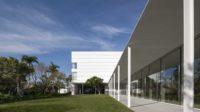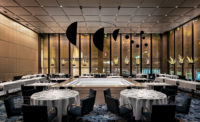Jean-Francois Bodin is probably the most talented architect you have never heard of.
He avoids publicity. His website is “in formation” though he opened his firm, Bodin and Associates, in 1983. He is modest to a fault. His spartan offices are located, with no sign, off of a nondescript 17th-century courtyard in the Marais section of Paris. He works around the corner from the neighborhood where he was born, grew up, and just spent the last five years reconfiguring the Musée Picasso, a quiet triumph of a project.
The tall, ruggedly handsome 67-year-old could be the star of a Clint Eastwood movie; he is craggy, bearded, chain-smoking, taciturn, and observant. He is a good listener, which may explain how he has worked so successfully for decades with such outsized personalities as Pierre Bergé, Yves Saint Laurent, Karl Lagerfeld, and Thierry Mugler. He has designed several museums, including the Musée Matisse in Nice, the CAPC contemporary art museum in Bordeaux, and the Musée d'Art Moderne in Paris. He has also created grand, minimalist art galleries for Yvon Lambert and Gagosian, as well as showrooms for Azzedine Alaia, Lacoste, and Issey Miyake.
The Musée Picasso, his latest exhibition space, opened on October 25, the 133rd anniversary of Picasso’s birth. Admission was free to the public for the day, and the street, Bodin says, was “crowded with people like at a demonstration.” His firm spent five years restoring and renovating the museum, which is housed in the Hôtel Salé, a magnificent Baroque mansion built by a tax collector in 1650s. It has been a long, arduous process, partly because parts of the building are listed as historic monuments and partly due to administrative problems. (Picasso scholar Anne Baldassari, the museum director for ten years, was fired in May over the project’s huge cost overruns and her controversial management style, despite the fact that her personal efforts reportedly helped raise more than half of the roughly $70 million cost of the renovation. She was replaced by Laurent Le Bon, the former director of the Louvre Metz, who asked her back temporarily to finish installing the collection this fall.)
The newly redone museum—a minimalist, glowing modern interior inside a stunning historic shell—is ravishingly beautiful. Bodin’s practice has nearly tripled the exhibition space, to 41,000 square feet. The architects relocated the administrative offices to a neighboring building and turned the ancient stables and a side courtyard into a soaring minimalist entrance hall, containing a new visitor entrance, ticket office, bookshop, café, and cloakrooms. They inserted spacious new galleries in the basement and opened up the loft-like attic, where Picasso’s collection of paintings by his friends hangs under the soaring 17th-century beams. As a result, all five floors are now dedicated to exhibition space. The designers also added an auditorium, museum workshop, and new staff facilities to the building and modernized the climate control, electrical, and other systems.
The interior is an exercise in restraint, with the décor designed to not steal the show. With typical understatement, Bodin describes the white-washed plaster galleries as having “disappearing walls—not a bad thing for a museum.” But Bodin’s plan is overly respectful of architect Roland Simounet’s 1985 renovation of the building, retaining two of its major missteps: many of the rooms are small, and the circulation is not obvious. Bodin is an admirer of Carlo Scarpa—as was Simounet—and the spaces recall Scarpa’s museums in Venice in that they are simple and over-refined.
Of course, only a fraction of the 5,000 Picasso paintings, sculptures, ceramics, and prints that make up the museum’s collection—all donated to the state by Jacqueline Picasso, Pablo’s second wife, and the family in lieu of taxes—are on view. But those in the inaugural exhibition are judiciously placed and are mostly allowed to breathe alongside the charming light fixtures and furnishings that Diego Giacometti designed for the museum.
Happily, Bodin and Associates completely restored the building’s Baroque double stair and stuccoed stair hall. It was supposedly inspired by Michelangelo's stair plan for the Laurentian Library in Florence and is equally theatrical—it is one of the grandest interiors in Paris, and the renovation unburdened it of a ticket booth and entrance facilities, bringing it back to its original purity. With so much drama in the existing building, Bodin made sure not to interrupt the show.



















Post a comment to this article
Report Abusive Comment